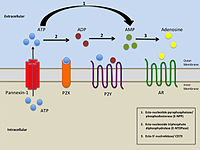
Photo from wikipedia
More than 50 years after spironolactone has come on the market its mechanism of action continues to expand. In this issue of Circulation Research , Good et al1 document the… Click to show full abstract
More than 50 years after spironolactone has come on the market its mechanism of action continues to expand. In this issue of Circulation Research , Good et al1 document the discovery that spironolactone is not only an inhibitor of the mineralocorticoid receptor but also inhibits pannexin 1 channels. Article, see p 606 Resistant hypertension (RH), defined as blood pressure (BP) >140/90 mm Hg despite the use of three antihypertensive agents, is well-recognized and not rare.2 For drug treatment of RH, first-line drug choices for BP control include (1) a diuretic (should be included unless not tolerated), (2) either an angiotensin-converting enzyme inhibitor or angiotensin-receptor blocker, and (3) a calcium channel blocker and in certain patients a β-blocker.3 Based on several smaller clinical trials, guidelines recommend to add the mineralocorticoid receptor (MR) antagonists spironolactone or eplerenone when BP remains uncontrolled.3 Recently the randomized controlled PATHWAY-2 trial showed a superior beneficial effect of spironolactone in patients on optimal three-drug regimen in a double-blind crossover setting over the alternative drugs bisoprolol (β-receptor blocker) and doxazosin (α-receptor blocker).4 Results showed that spironolactone lowered systolic BP by −8.7 mm Hg, whereas bisoprolol and doxazosin were also effective but inferior with −4.5 mm Hg and −4.0 mm Hg reduction, respectively. Spironolactone’s well-recognized mode of action is the antagonism of the MR in the distal tubule of the kidney. Activation of the MR by aldosterone leads to its translocation into the nucleus and subsequent changes in gene expression. The net effect on ion and water homeostasis is sodium retention, volume increase, and potassium excretion. Antagonizing the MR has therefore the opposite …
Journal Title: Circulation Research
Year Published: 2018
Link to full text (if available)
Share on Social Media: Sign Up to like & get
recommendations!